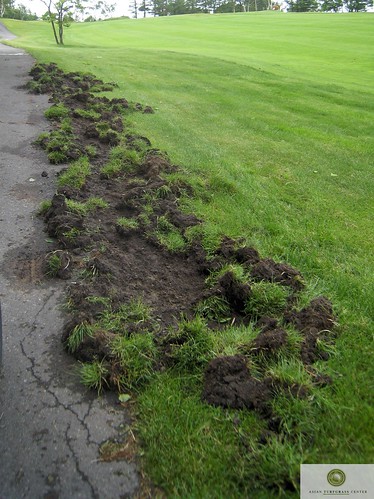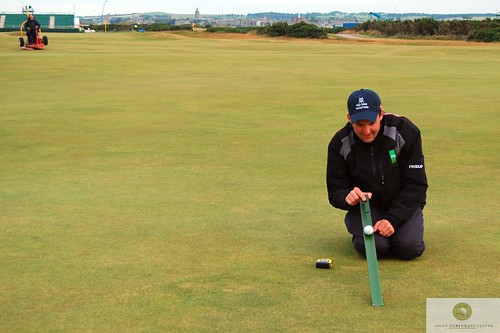After reading disease updates over the past two months from our university professors in the United States, I am thankful that I have a chance to work in many areas where warm-season grasses are grown, or where cool-season grasses are especially well-adapted, and to be able to avoid what seems to be nearly impossible weather for growing cool-season turf. What I've seen personally this summer is nothing too severe.
Figure 1. Damage from foraging pigs on a golf course at Nagano prefecture, Japan.
I've seen a bit of anthracnose on Poa annua at Japan, damage from foxes and rabbits at England, from wild pigs at Japan (Figure 1), some hydrophobic soil conditions at Dubai, even some lingering large patch into June on Zoysia japonica in the mountains of Nagano, and red thread at Scotland in July. Fairy ring appears ubiquitously on all types of turf (see Figure 2 below). Now I am hearing of extreme weather and heavy rainfall at Singapore that is causing challenges to turf, along with extreme heat in North Asia that is putting creeping bentgrass under severe stress. That is all I have to mention about diseases in this post.
But I do want to share a few thoughts that I have had this summer, which I make bold to post here thinking a few people may be interested in a temporary diversion from the mathematical certainty of x + y = dead grass. And as I am writing this from Bogor, 6° South of the equator on the island of Java, I can claim, in an astronomical sense, if not a meteorological one, that it is winter here today. Thus, my Winter Notes on Summer Impressions:
1. A quote that seems particularly apt this year is this one, from the introduction to the book Practical Golf Greenkeeping, published at London nearly 100 years ago. "To my mind . . . the most impressive lesson any greenkeeper can learn, is the one acquired under adversity. The real science in greenkeeping is not to be gained where difficulties in maintaining the turf are never experienced. Practical tests in overcoming trouble of any kind are the best way to obtain knowledge.” Small solace perhaps, but as true today as it was a century ago.
2. I am becoming more and more uncomfortable when I hear imprecise terms and phrases related to golf course appearance and playability. Whether that be something about "firm and fast" or "brown is the new green," I find these terms to be imprecise and particularly susceptible to misunderstanding. I think of an article co-authored in 1916 by Charles Vancouver Piper, first chairman of the USGA Green Section, in which he wrote, "The function of language is to convey ideas. Unless the language is understood in the same way by writer and reader this function is not served and ideas are not transmitted exactly . . . It is becoming increasingly evident that the terminology of agronomy is not always clear."
Figure 2. Richard Windows of STRI using a stimpmeter at the Open Championship with symptoms of fairy ring visible on the green.
Golf is a game. The physical characteristics of the playing surface are crucial to the enjoyment of the game, but these characteristics are not well-described by terms such as firm, fast, brown, green, or sustainable, unless those terms are put into some type of context, or are measured. The STRI Programme, which takes a quantitative measure of the performance of the playing surface at a golf course and puts a value on ball roll distance, surface firmness, surface smoothness, and other important characteristics, is a system for measuring these physical characteristics and can lead to the exact transmittal of ideas. I had a chance to work with the STRI tournament agronomy team at the Open Championship in July. After seeing this firsthand, and thinking about it as a golfer, former superintendent, and scientist, I am excited about the usefulness of the STRI Programme and the removal of so much ambiguity from terms used to describe golf course appearance and playability.
3. Does anyone else think that "corrective watering" is a particularly egregious term? I first heard this at the US Open in June, and this week read an article about Sahalee and the US Senior Open where the term was used again. "Corrective" implies that something was done wrong, that an error is being put right. Wouldn't "supplemental irrigation" be a more appropriate description of water being applied to the turf? If "corrective watering" is a term that should persist, maybe "disciplinary mowing" and "interventional rolling" could be added to this malapropistic vocabulary.
Winter Notes on Summer Impressions
Posted by
Micah Woods
at
12:03 PM
Sunday, August 1, 2010
Labels:
fairy ring
,
international
,
warm-season




















4 Responses to “Winter Notes on Summer Impressions”
Micah,
I think that the USGA is going to stick to corrective watering whether is it actually descriptive or not. My understanding that by "correctional" watering it is more like "targeted" watering in which they treat specifically targeted areas to bring the entire putting surface to similar playable conditions. I guess "correctional" works in that they are correcting water deficiencies in specific areas. These decisions too are based on data from greenspeed and firmness readings.
JK
They may stick with it, but it makes me cringe because there is a definite connotation that something has gone slightly wrong, or someone has made a mistake, and that an error must be corrected. The superintendent and course maintenance staff can do a perfect job preparing everything for the event, and then suddenly there have to be "corrections" made all over the course? Using such terminology adds an air of benevolent incompentence to the course preparations!
This is the problem which we all are facing with our turf and grass. Extreme diversified climate keeps us on toes to maintain and keep up working on watering and correction methods.
I was very encouraged to find this site. I wanted to thank you for this special ride. I definitely savored every little bit of it and I have you bookmarked to check out new stuff you post.
Sod California
Post a Comment